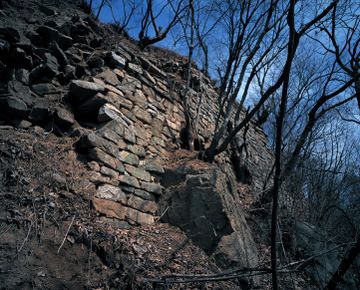성동리산성(태봉산성)
| 성동리산성 Fortress in Seongdong-ri (Taebongsanseong Fortress) |
|
 성동리산성, 이미지 라이브러리, 네이버. |
|
| 대표명칭 | 성동리산성 |
|---|---|
| 영문명칭 | Fortress in Seongdong-ri (Taebongsanseong Fortress) |
| 한자 | 城洞里山城 |
| 주소 | 경기도 포천시 영중면 성동리 763 |
| 지정(등록) 종목 | 포천시 향토유적 제29호 |
| 지정(등록)일 | 1986년 4월 9일 |
| 소유자 | 사유 |
|
|
|
해설문
국문
포천시 영중면 성동리에 있는 태봉산에 쌓은 산성이다.
‘태봉성’ 혹은 ‘태봉산성’이라고 부르기도 하는데, 여기에는 두 가지 설이 전해진다. 첫 번째는 궁예(弓裔, ?~918)가 911년에 세운 나라 이름 ‘태봉(泰封)’을 뜻한다는 것이다. 궁예가 왕건에게 왕위를 빼앗기고 쫓길 때 급히 이 산성을 쌓았다는 설이 있다. 두 번째는 ‘태(胎)를 묻은 곳’이라는 설이다. 실제 이곳에 조선 순조(1800~1834 재위)의 아들 익종(효명세자, 1809~1830)의 태실이 있었다는 기록이 남아 있다.
이 산성은 포천~철원 방면의 남북 교통로와 연천~포천 방면의 동서 교통로가 교차하는 전략적 요충지에 위치하고 있다. 현재 높이 2~5m, 둘레 1~2km 정도 되는 성벽이 불연속적으로 남아있다. 조사 결과 3~5세기 백제 시대에 처음 만들어졌으며, 그 뒤 고구려와 신라 그리고 태봉 때에도 사용되었음이 밝혀졌다. 그중 백제와 신라가 가장 활발하게 이용한 것으로 파악되고 있다.
영문
Fortress in Seongdong-ri (Taebongsanseong Fortress)
This stone fortress encircling Taebongsan Mountain (180 m above sea level) in Seongdong-ri is presumed to have been built in the 3rd-5th centuries by the Baekje kingdom (18 BCE-660 CE). It was also used by the two other ancient Korean kingdoms, Goguryeo and Silla, as they all competed over this important territory in the center of the peninsula. Located at a strategically important historic crossroad, the fortress continued to be used during the Unified Silla (668-935) and Goryeo (918-1392) periods. Only some sections of the fortress wall remain, measuring 2-5 m in height.
There are two theories about the name of the peak on which the fortress is located, Taebong. First, it may refer to the kingdom established in 901 by Gungye (?-918) during the decline of the Silla kingdom. According to a legend, he built this fortress while on the run from Wang Geon (877-943), who eventually took over the kingdom and renamed it Goryeo. Second, the name may refer to the fact that the placenta chamber of Crown Prince Hyomyeong (1809-1830), the father of King Heonjong (r. 1834-1849) of the Joseon dynasty (1392-1910), was buried at this mountain. During the Joseon period, the placentas of royal babies were buried at auspicious places to wish for the good fortune and health of the baby. The mountains where placenta chambers were buried were often called Taebong, meaning “placenta peak.”